
- SAP Community
- Products and Technology
- Technology
- Technology Blogs by SAP
- How to Install SAP Identity Management 8.0 as a Di...
Technology Blogs by SAP
Learn how to extend and personalize SAP applications. Follow the SAP technology blog for insights into SAP BTP, ABAP, SAP Analytics Cloud, SAP HANA, and more.
Turn on suggestions
Auto-suggest helps you quickly narrow down your search results by suggesting possible matches as you type.
Showing results for
Product and Topic Expert
Options
- Subscribe to RSS Feed
- Mark as New
- Mark as Read
- Bookmark
- Subscribe
- Printer Friendly Page
- Report Inappropriate Content
08-29-2018
9:45 AM
If installing SAP Identity Management (IdM) 8.0 as a distributed system is a challenge, let’s go for it.
In a distributed system, every instance can run on a separate host, thus ensuring scalability of the system and load sharing of the processing.
This blog post will focus on installing IdM Core on one host and IdM Runtime, IdM deployables on AS Java and Virtual Directory Server on a second host. To achieve this, we will use the Software Provisioning Manager (SWPM) 1.0 installation tool (the only available and supported installation option for new IdM installations). The operating system is Windows and the database system - MS SQL Server. For more information about a standard system installation on one host, see How to Install SAP Identity Management 8.0 with Software Provisioning Manager 1.0
Beforehand, we assume that all required prerequisites are fulfilled, as described in the IdM installation guide.
Note that, when an SAP system, such as IdM, is to be distributed across more than one machine, SAP strongly recommends that you perform a domain installation (all machines belong to the same domain) to avoid authorization problems.
The IdM Core component that contains the IdM database is now installed on the SAP Global host. The global directory usr\sap\<SAPSID>\SYS, which physically exists only once for each SAP system, is created. It has the following subdirectories:
The IdM Runtime is now installed on the second host.The initial dispatcher is created and set as the default one. All dispatcher settings are defined, including the connection strings to access the IdM database with your <prefix>_admin user and the <prefix>_rt user.
The IdM deployable components on SAP NetWeaver AS Java are now installed. You can proceed with installing the Identity Management Developer Studio (available as an Eclipse plugin) and the initial configuration of all components, described in the post-installation section.
The Virtual Directory server is now installed. You can proceed with starting the VDS and its initial configuration, described in the post-installation section.
In a distributed system, every instance can run on a separate host, thus ensuring scalability of the system and load sharing of the processing.
This blog post will focus on installing IdM Core on one host and IdM Runtime, IdM deployables on AS Java and Virtual Directory Server on a second host. To achieve this, we will use the Software Provisioning Manager (SWPM) 1.0 installation tool (the only available and supported installation option for new IdM installations). The operating system is Windows and the database system - MS SQL Server. For more information about a standard system installation on one host, see How to Install SAP Identity Management 8.0 with Software Provisioning Manager 1.0
Beforehand, we assume that all required prerequisites are fulfilled, as described in the IdM installation guide.
Note that, when an SAP system, such as IdM, is to be distributed across more than one machine, SAP strongly recommends that you perform a domain installation (all machines belong to the same domain) to avoid authorization problems.
Installing IdM Core Component on the First Host
- Log on to the first installation host using an account with the required user authorization to run the installer. This is the host where IdM Core component is to be installed. It is called SAP Global Host.
- Start SWPM by executing sapinst.exe from the directory to which you unpacked the latest version of SWPM10SP<Support_Package_Number>_<Version_Number>.SAR file.
Use Google Chrome. - Choose SAP Identity Management 8.0 -> Installation -> Distributed System -> SAP Identity Management Core Component.

- Run the installation in a Typical mode.
- Enter the SAP System ID.

- Enter the master password for all users.
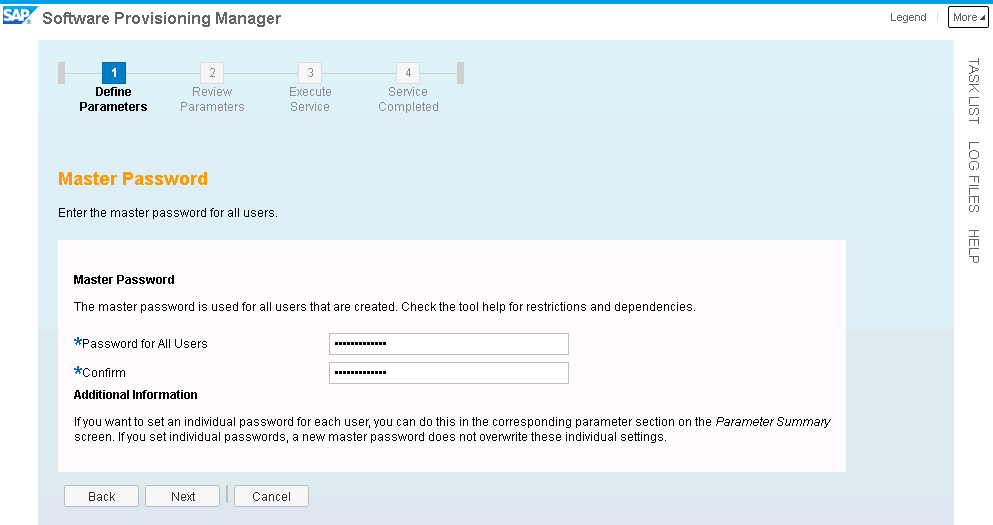
- Provide the path to all required SAR archives. You can either download them to a local directory before you start the installation or do it right away from the specified locations on the SAP Software Download Center.
- Choose to upgrade SAP Host Agent and provide the path to it.
- Select the database system.

- Enter the database host and port of the server where the IdM database is to run.

- Enter the credentials for the IdM database.

- Enter the prefix of the IdM database and the base-qualified name that is used for the IdM packages.

- Enter the parameters for the IdM database users.
- The master password that you provided in Step 6 is populated in the password fields for the IdM database users. You can keep it and proceed further or provide individual passwords.
- Enter the name of the developer administrator user. This is the name of the initial developer administrator that is used to log on to the Identity Management Developer Studio. The initial developer administrator user must be named the same in the database and the UME.

- Select the encryption and hash algorithm.

- Review your parameters. If you want to change a parameter, select it and choose Revise. Then, choose Next to run the installation.
- When the message “Execution of Service has been completed successfully.” appears, choose OK and then Exit.

The IdM Core component that contains the IdM database is now installed on the SAP Global host. The global directory usr\sap\<SAPSID>\SYS, which physically exists only once for each SAP system, is created. It has the following subdirectories:
- global - globally shared data
This is where the Keys.ini file resides. During the installation, SWPM places the Keys.ini file into the /usr/sap/<SAPSID>/SYS/global/security/data directory on the database host, that is the SAP Global host. Then the Keys.ini file is shared with the network share sapmnt and distributed to every IdM Runtime instance.
Later, whenever you need to specify the path to Keys.ini file, make sure you give the following one: \\<SAPGLOBALHOST>\sapmnt\<SAPSID>\SYS\global\security\data\Key\Keys.ini - profile - the profiles for all instances
- exe - executable replication directory for all instances and platforms
Installing IdM Runtime, Deployable Components and VDS on the Second Host
Installing IdM Runtime
- Log on to the second installation host using an account with the required user authorization to run the installer.
- Start SWPM by executing sapinst.exe from the directory to which you unpacked the SWPM archive.
Use Google Chrome. - Choose SAP Identity Management 8.0 -> Installation -> Distributed System -> SAP Identity Management Dispatcher Instance.
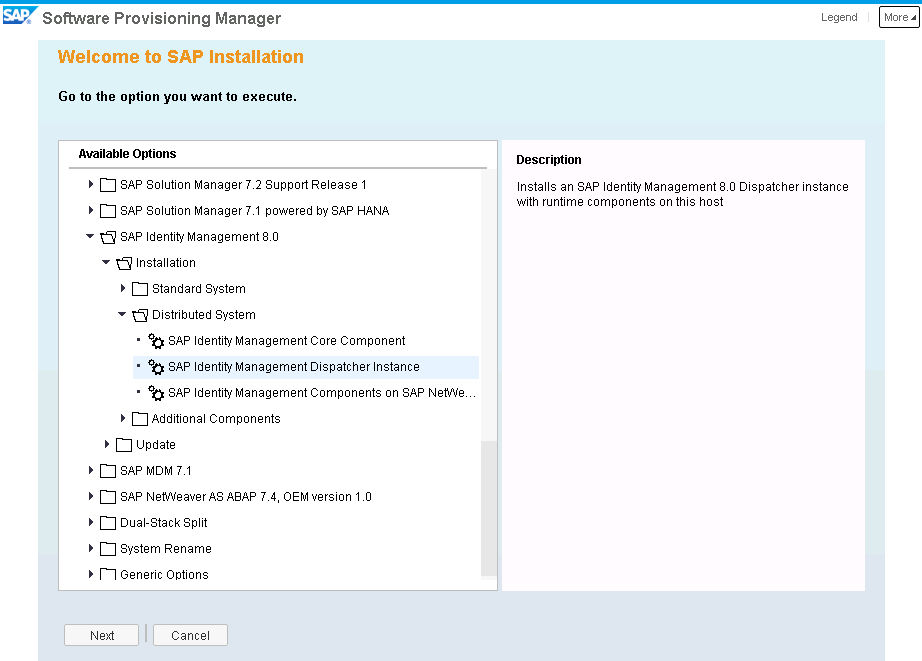
- Run the installation in a Typical mode.
- Enter the profile directory of your IdM system, where <SAPGLOBALHOST> is the host of the IdM Core installation and <SAPSID> is SAP system ID of IdM.

- Enter the master password for all users that you have provided when installing IdM Core.
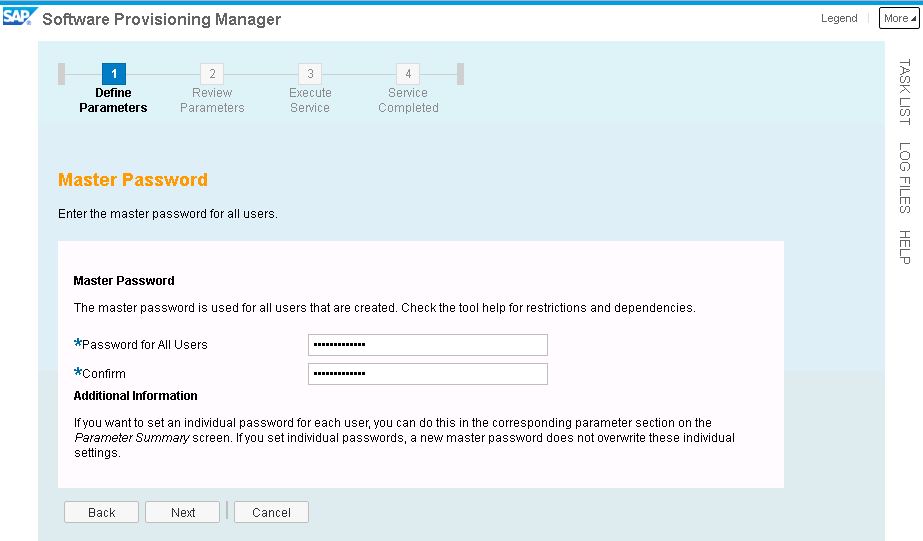
- Provide the path to all required SAR archives. You can either download them to a local directory before you start the installation or do it right away from the specified locations on the SAP Software Download Center.
- Choose to upgrade SAP Host Agent and provide the path to it.
- Enter the instance number that is assigned to the IdM Dispatcher instance or use the one that is set automatically.

- Browse for the JDBC driver path and enter the JDBC driver class name.

- Enter the passwords for the <prefix>_admin and <prefix>_rt users.
Remember the passwords you have provided while installing IdM Core (step 13).
- If you have set a master password for all users, provide it here.
- If you have set individual passwords for those users, provide them here.

- Review your parameters and choose Next to run the installation.
- When the installation completed successfully, choose OK and then Exit.
The IdM Runtime is now installed on the second host.The initial dispatcher is created and set as the default one. All dispatcher settings are defined, including the connection strings to access the IdM database with your <prefix>_admin user and the <prefix>_rt user.
Installing Deployable Components on AS Java
- Log on to the second installation host and start again SWPM.
- Choose SAP Identity Management 8.0 -> Installation -> Distributed System -> SAP Identity Management Components on SAP NetWeaver AS Java.
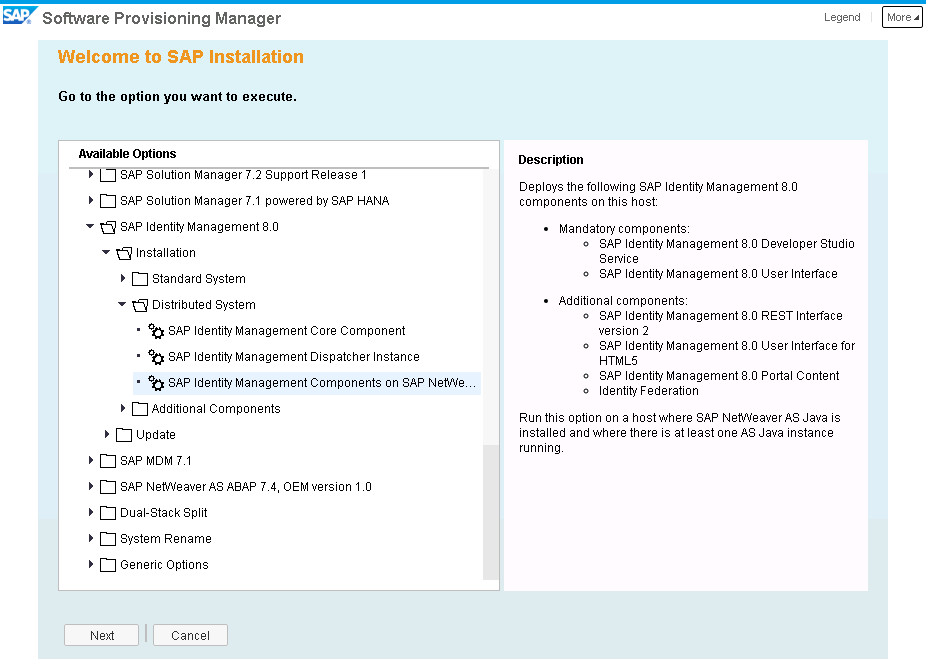
- Run the installation in a Typical mode and then enter the profile directory of your IdM system.
- Enter the passwords of the OS users.
This is the master password for all users that you have already provided.
- Enter the SAP system ID of the SAP NW Java system to be used for IdM deployable components.

- Confirm or enter your SAP NetWeaver release and Support Package.
- Enter the credentials of the administrator of the AS Java.
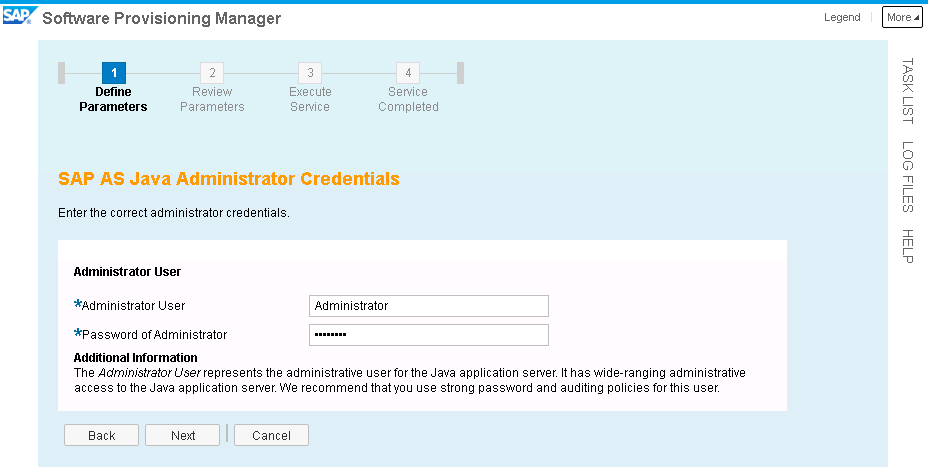
- Select the IdM components that you want to deploy.

- Provide the path to all required SAR archives, review your parameters and run the installation.
The IdM deployable components on SAP NetWeaver AS Java are now installed. You can proceed with installing the Identity Management Developer Studio (available as an Eclipse plugin) and the initial configuration of all components, described in the post-installation section.
Installing Virtual Directory Server
- Log on to the second installation host and start again SWPM.
- Choose SAP Identity Management 8.0 -> Installation -> Additional Components -> SAP Identity Management Virtual Directory Server.

- Run the installation in a Typical mode and then enter the profile directory of your IdM system.
- Enter the master password for all users.
- Provide the path to all required SAR archives.
- Enter the instance number that is assigned to the VDS instance or use the one that is set automatically.

- Review your parameters and run the installation.
- When the installation completed successfully, choose OK and then Exit.

The Virtual Directory server is now installed. You can proceed with starting the VDS and its initial configuration, described in the post-installation section.
- SAP Managed Tags:
- SAP Identity Management,
- software logistics toolset
11 Comments
You must be a registered user to add a comment. If you've already registered, sign in. Otherwise, register and sign in.
Labels in this area
-
ABAP CDS Views - CDC (Change Data Capture)
2 -
AI
1 -
Analyze Workload Data
1 -
BTP
1 -
Business and IT Integration
2 -
Business application stu
1 -
Business Technology Platform
1 -
Business Trends
1,658 -
Business Trends
93 -
CAP
1 -
cf
1 -
Cloud Foundry
1 -
Confluent
1 -
Customer COE Basics and Fundamentals
1 -
Customer COE Latest and Greatest
3 -
Customer Data Browser app
1 -
Data Analysis Tool
1 -
data migration
1 -
data transfer
1 -
Datasphere
2 -
Event Information
1,400 -
Event Information
66 -
Expert
1 -
Expert Insights
177 -
Expert Insights
299 -
General
1 -
Google cloud
1 -
Google Next'24
1 -
Kafka
1 -
Life at SAP
780 -
Life at SAP
13 -
Migrate your Data App
1 -
MTA
1 -
Network Performance Analysis
1 -
NodeJS
1 -
PDF
1 -
POC
1 -
Product Updates
4,577 -
Product Updates
345 -
Replication Flow
1 -
RisewithSAP
1 -
SAP BTP
1 -
SAP BTP Cloud Foundry
1 -
SAP Cloud ALM
1 -
SAP Cloud Application Programming Model
1 -
SAP Datasphere
2 -
SAP S4HANA Cloud
1 -
SAP S4HANA Migration Cockpit
1 -
Technology Updates
6,873 -
Technology Updates
427 -
Workload Fluctuations
1
Related Content
- Supporting Multiple API Gateways with SAP API Management – using Azure API Management as example in Technology Blogs by SAP
- SAP Cloud ALM and Identity Authentication Service (IAS) in Technology Blogs by SAP
- Consuming SAP with SAP Build Apps - Mobile Apps for iOS and Android in Technology Blogs by SAP
- IoT - Ultimate Data Cyber Security - with Enterprise Blockchain and SAP BTP 🚀 in Technology Blogs by Members
- Empowering Retail Business with a Seamless Data Migration to SAP S/4HANA in Technology Blogs by Members
Top kudoed authors
| User | Count |
|---|---|
| 41 | |
| 25 | |
| 17 | |
| 14 | |
| 9 | |
| 7 | |
| 6 | |
| 6 | |
| 6 | |
| 6 |